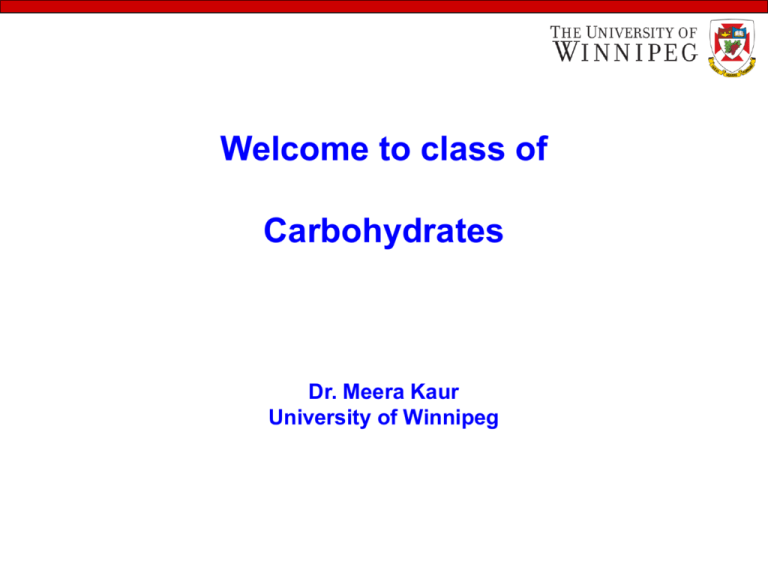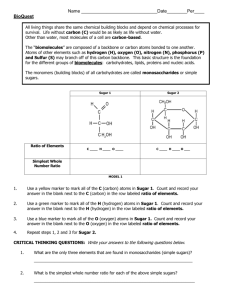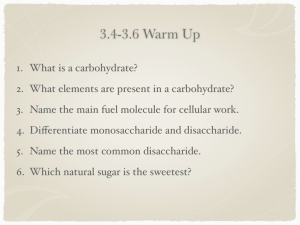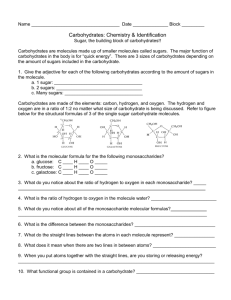cellulose - University of Winnipeg
advertisement

Welcome to class of Carbohydrates Dr. Meera Kaur University of Winnipeg Learning objectives • To understand carbohydrates as an important biomolecule • To learn the classifications of carbohydrates • To understand the basic structures and properties of carbohydrates • To learn the functions of carbohydrates • To know the deficiency and excess of carbohydrates in human body Introduction Carbohydrates are the most abundant biomolecules. They serve as: • the major source of energy for plant kingdom and humankind (4kcal/g) • supportive structural components in plant (cellulose) • essential components in the mechanism of genetic control of growth and development in living cells (ribose and deoxyribose) Electron micrograph of the erythrocyte surface. Its thick (up to 1400 A) carbohydrate coat, called the glycocalyx, consists of closely packed oligosaccharides attached to cell-surface proteins and lipids. Definitions • Carbohydrates are polyhydroxy aldehydes or ketones or substances that yield such compounds on hydrolysis (hydrates of carbon) – Some carbohydrates also contain nitrogen, phosphorus or sulfur. – They are referred as saccharides from the latin word saccharum which means ‘sugar’. – The simpler members of the carbohydrtaes family often give a sweet taste. They have a suffix -ose Empirical formula: (CH2O)n Classifications Monosaccharides -Glucose (blood sugar) -Fructose (honey) Galactose Disaccharides - Sucrose (table sugar) - Lactose (milk sugar) -Maltose (malt sugar) Polysaccharides - Starch (Corn starch) - Glycogen (liver) - Cellulose (cotton fibre) - Hemi-cellulose (dietary fibre) Monosaccharides… • They are the simplest carbohydrates • The general formula is CnH2nOn Classifications Triose (C3H6O3) Tetrose(C4H8O4) Pentose(C5H10O5) Hexose(C6H12O6) Heptose(C7H14O7) Octose(C8H16O8) Properties of monosaccharides… – Colorless crystaline solids that are freely soluble in water but insoluble in non polar solvents( alcohol, ether etc.) – Backbone is an unbranched carbon chain where all the carbon atoms are linked by single bond – Consist of a single polyhydroxy aldehyde or ketone unit – One of the carbon atom is double bonded to to form a carbonyl group; each of the other carbon atom has a hydroxyl group – Depending upon the position of the carbonyl group they are either aldose or ketose. Triose Aldoses Triose Tetrosse Ketoses Examples of aldopentoses (5-carbon aldoses) Pentoses Examples of ketopentoses (5-carbon ketoses) Hexoses Examples of aldohexoses (6-carbon aldoses) Examples of ketohexoses (6-carbon ketoses) The D-aldoses with 3-6 carbon atom The ketoses with 3-6 carbon atoms Properties of monosaccharides… • Mono Saccharides have asymmetric (chiral centre): means in a carbon atom all the groups are different. The exception is dehydroxyacetone • Compounds whose molecules contain one asymmetric carbon have handedness ie there is two kind of molecules with same structural formula • Also known as stereoisomers ie molecules of the same structural formula with different arrangement of groups Fischer projections • Fischer projections allow us to represent three dimensional organic moleculer structure in in two dimensions. They are a convenient means of differentiating sterioisomers • In Fischer projections: – Functional group is always at the top – Carbon chain is written vertically with substituent groups to the left and right – The groups to the right and left of the asymmetric carbon are above the plane, the chain carbon are below the plane – The hydroxyl group to the right of the carbon chain is D form and to the left is L form of the sugar. Virtually all sugars found in nature are of the D family Properties of monosaccharides… • Common monosaccharides (pentoses and hexoses) occur in cyclic forms(closed chain) • The five and the six membered sugar ring system is known as furanose and pyranose respectively • The stereochemistry of cyclic forms of sugar is depicted by Haworth projections, the standardized ways of depicting the positions of the hydroxyl groups in space (Pl. refer to the hand out for additional knowledge) Properties of monosaccharides… • Simple monosaccharides are reducing agent • They are oxidised by mild oxiding agent like ferric (Fe3+) or cupric(Cu) ions • This property is the basis for Fehling’s reaction, a qualitative test for the presence of reducing sugars eg. glucose Aldoses can be oxidized (while something else gets reduced) and so are known as “reducing sugars”. Properties of monosaccharides… Optical activity The D and L from of handed pairs of stereoisomers are identical in their physical and chemical properties, except that they rotate plane-polarized light in opposite direction Plane-polarized light is the light in which vibrations are in only one direction. So, handed pairs of stereoisomers are often called optical isomers Optical isomers are handed stereoisomers that rotate plane- polarized light in opposite directions e.g. D-glyceraldehyde and L- glyceraldehyde rotate planepolarized light to the right and left respectively Properties of monosaccharides… -The - and the - forms of monosaccharides are readily interconvertable in aquous solution -The changes in specific rotation that accompanies this interconversion is known as mutarotation Examples: a freshly prepared solution of -D-glucose shows an initial rotation of +1120 to +520. Similarly, a solution of -D glucose undergoes mutaroatation from +190 to +520 Mutarotation Glucose family Disaccharides When two monosaccharides join together, they form a disaccharide.eg.Lactose How monosaccharides are joined? Two monosaccharides are covalently joined to form a glycosidic bond How a glycosidic bond is formed? When the hydroxyl group of one sugar reacts with the anomeric carbon of the other sugar, one water molecule is eliminated and a glycosidic bond is formed. Structures of some disaccharides Polysaccharides Definitions: carbohydrates containing many monosaccharides units connected by a glycisidic bond are called polysaccharides Storage polysaccharides Structural Polysaccharides Starch (plant) Glycogen (liver) Cellulose (bark) Chitin(crabs, lobster) Hyaluronic acids (connective tissues) Chitin (shells of crabs, lobsters) Storage Polysaccharides Starch Amylose Amylopectin glucose units: 60-300 300-6000 Mol.Wt.10,000-50,000 50,000-1,000,000 Chain: Straight structure Highly branched structure Joined by: -1,4-glycosidic 1,6linkage -1,4-glycosidic + glycosidic linkage Cellulose Structural Polysaccharides The important structural polysaccharide is cellulose - it is the material of plant cell walls, as in wood - is a linear polymer of D- glucose units (300, 15,000) - They are linked by beta 1-4 linkage Blood group antigens: notice difference in oligosaccharide structure Castor bean plant From http://www.portfolio.mvm.ed.ac.uk/studentwebs/session2/group12/ricin.htm Ricin from http://www.portfolio.mvm.ed.ac.uk/studentwebs/session2/group12/ricin.htm




